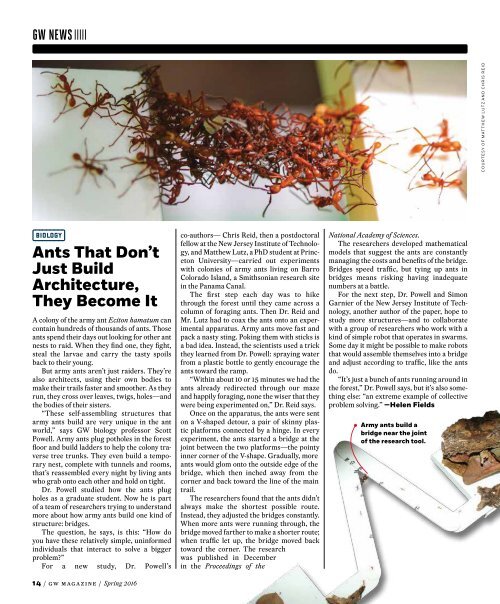Create successful ePaper yourself
Turn your PDF publications into a flip-book with our unique Google optimized e-Paper software.
GW NEWS<br />
COURTESY OF MATTHEW LUTZ AND CHRIS REID<br />
[biology]<br />
Ants That Don’t<br />
Just Build<br />
Architecture,<br />
They Become It<br />
A colony of the army ant Eci<strong>to</strong>n hamatum can<br />
contain hundreds of thousands of ants. Those<br />
ants spend their days out looking for other ant<br />
nests <strong>to</strong> raid. When they find one, they fight,<br />
steal the larvae and carry the tasty spoils<br />
back <strong>to</strong> their young.<br />
But army ants aren’t just raiders. They’re<br />
also architects, using their own bodies <strong>to</strong><br />
make their trails faster and smoother. As they<br />
run, they cross over leaves, twigs, holes—and<br />
the bodies of their sisters.<br />
“These self-assembling structures that<br />
army ants build are very unique in the ant<br />
world,” says GW biology professor Scott<br />
Powell. Army ants plug potholes in the forest<br />
floor and build ladders <strong>to</strong> help the colony traverse<br />
tree trunks. They even build a temporary<br />
nest, complete with tunnels and rooms,<br />
that’s reassembled every night by living ants<br />
who grab on<strong>to</strong> each other and hold on tight.<br />
Dr. Powell studied how the ants plug<br />
holes as a graduate student. Now he is part<br />
of a team of researchers trying <strong>to</strong> understand<br />
more about how army ants build one kind of<br />
structure: bridges.<br />
The question, he says, is this: “How do<br />
you have these relatively simple, uninformed<br />
individuals that interact <strong>to</strong> solve a bigger<br />
problem?”<br />
For a new study, Dr. Powell’s<br />
14 / gw magazine / Spring 2016<br />
co-authors— Chris Reid, then a postdoc<strong>to</strong>ral<br />
fellow at the New Jersey <strong>In</strong>stitute of Technology,<br />
and Matthew Lutz, a PhD student at Prince<strong>to</strong>n<br />
University—carried out experiments<br />
with colonies of army ants living on Barro<br />
Colorado Island, a Smithsonian research site<br />
in the Panama Canal.<br />
The first step each day was <strong>to</strong> hike<br />
through the forest until they came across a<br />
column of foraging ants. Then Dr. Reid and<br />
Mr. Lutz had <strong>to</strong> coax the ants on<strong>to</strong> an experimental<br />
apparatus. Army ants move fast and<br />
pack a nasty sting. Poking them with sticks is<br />
a bad idea. <strong>In</strong>stead, the scientists used a trick<br />
they learned from Dr. Powell: spraying water<br />
from a plastic bottle <strong>to</strong> gently encourage the<br />
ants <strong>to</strong>ward the ramp.<br />
“Within about 10 or 15 minutes we had the<br />
ants already redirected through our maze<br />
and happily foraging, none the wiser that they<br />
were being experimented on,” Dr. Reid says.<br />
Once on the apparatus, the ants were sent<br />
on a V-shaped de<strong>to</strong>ur, a pair of skinny plastic<br />
platforms connected by a hinge. <strong>In</strong> every<br />
experiment, the ants started a bridge at the<br />
joint between the two platforms—the pointy<br />
inner corner of the V-shape. Gradually, more<br />
ants would glom on<strong>to</strong> the outside edge of the<br />
bridge, which then inched away from the<br />
corner and back <strong>to</strong>ward the line of the main<br />
trail.<br />
The researchers found that the ants didn’t<br />
always make the shortest possible route.<br />
<strong>In</strong>stead, they adjusted the bridges constantly.<br />
When more ants were running through, the<br />
bridge moved farther <strong>to</strong> make a shorter route;<br />
when traffic let up, the bridge moved back<br />
<strong>to</strong>ward the corner. The research<br />
was published in December<br />
in the Proceedings of the<br />
National Academy of Sciences.<br />
The researchers developed mathematical<br />
models that suggest the ants are constantly<br />
managing the costs and benefits of the bridge.<br />
Bridges speed traffic, but tying up ants in<br />
bridges means risking having inadequate<br />
numbers at a battle.<br />
For the next step, Dr. Powell and Simon<br />
Garnier of the New Jersey <strong>In</strong>stitute of Technology,<br />
another author of the paper, hope <strong>to</strong><br />
study more structures—and <strong>to</strong> collaborate<br />
with a group of researchers who work with a<br />
kind of simple robot that operates in swarms.<br />
Some day it might be possible <strong>to</strong> make robots<br />
that would assemble themselves in<strong>to</strong> a bridge<br />
and adjust according <strong>to</strong> traffic, like the ants<br />
do.<br />
“It’s just a bunch of ants running around in<br />
the forest,” Dr. Powell says, but it’s also something<br />
else: “an extreme example of collective<br />
problem solving.” —Helen Fields<br />
Army ants build a<br />
bridge near the joint<br />
of the research <strong>to</strong>ol.


